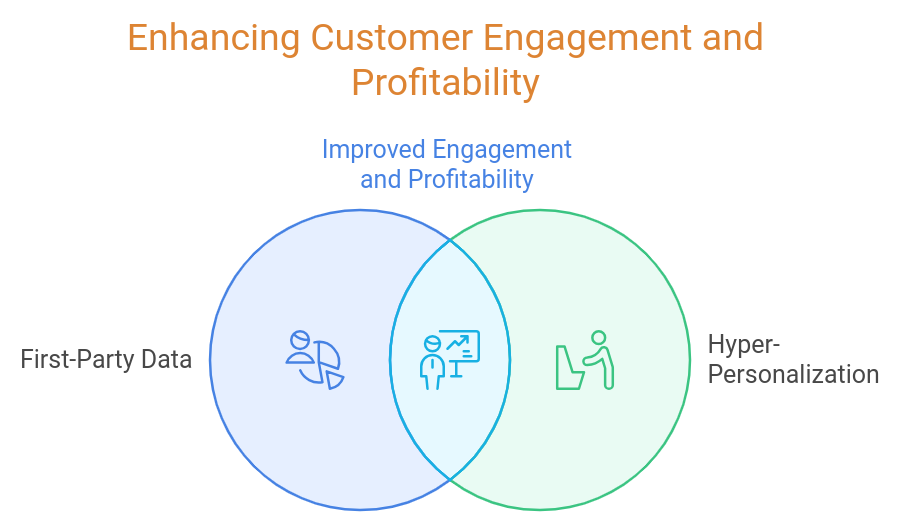In today’s competitive marketplace, customers expect businesses to know their unique needs and preferences. But as a small business owner, how can you compete with big brands that have massive marketing budgets? The answer lies in hyper-personalisation powered by first-party data. In this blog, we’ll explore what hyper-personalisation is, how to utilize first-party data effectively, and actionable strategies you can implement today. Let’s dive in!
What Is Hyper-Personalisation and Why Does It Matter?
The practice of tailoring your marketing messages, services, and experiences to individual customers by leveraging advanced data analytics. It goes beyond basic personalisation (like addressing an email to someone by name) to deliver highly relevant content based on real customer behaviors and preferences.
For small businesses, hyper-personalisation can level the playing field. By providing a superior, tailored customer experience, you can improve engagement, build loyalty, and outshine big competitors. The power to achieve this lies in the data you already own: your first-party data.
Understanding First-Party Data
What Is First-Party Data?
First-party data is information you collect directly from your customers through your website, email sign-ups, purchase history, social media interactions, and more. Since it comes directly from your audience, this data is yours to own, accurate, and often compliant with privacy laws.
Why Is First-Party Data So Valuable?
Unlike third-party data (which often comes from external sources and can sometimes lack accuracy), first-party data is tailored to your business and customers. It’s high-quality, reliable, and allows you to forge stronger connections through meaningful insights. Plus, it aligns with data privacy trends like GDPR and CCPA, giving your customers more control over their data.
Pro Tip:
Regularly review how you collect and store first-party data to remain compliant and maintain customer trust. A privacy-friendly approach is key.
How First-Party Data Drives Personalisation
First-party data provides a treasure trove of information that can help you understand what your customers truly want. Are they browsing specific products but not purchasing? Do they respond better to email campaigns or social media ads? Each data point reveals a story about their preferences and behaviors, allowing you to craft truly personalised experiences.
For example, consider Netflix’s recommendations. The platform uses first-party data (like viewing history) to suggest shows you’re likely to love. Small businesses can adopt similar tactics by leveraging their own customer data.
Actionable Strategies for Small Businesses
- Data Integration: Combine data from your website analytics, CRM, and point-of-sale systems to create unified customer profiles.
- Segmentation: Break your audience into micro-segments based on their location, preferences, purchase history, or demographics.
- Personalised Offers: Send targeted promotions or recommendations. For instance, if a customer recently bought a winter coat, offer discounts on scarves or gloves.
Stat to Know:
Brands using first-party data effectively have been able to reduce acquisition costs by 50% and increase revenues by 5-15% (source: McKinsey & Company).
Interactive Question:
What kind of first-party data are you currently collecting, and how could you use it to enhance customer experiences?
Case Study: A Small Business Success Story
Let’s look at a real-world example. A small, family-owned tea shop decided to start collecting first-party data by asking customers to sign up for a “Tea of the Month” newsletter. They tracked each subscriber’s preferences (herbal vs. caffeinated teas) and purchasing history over time.
Using this data, the shop began sending personalised email recommendations. If a customer frequently bought green tea, they’d suggest new green tea blends or accessories like teapots. Within six months, newsletter sales doubled, and customer retention improved significantly.
Key Takeaway:
Even small, incremental steps towards personalisation can lead to measurable improvements in sales and engagement.
The Role of Tools and Technology
You don’t have to tackle hyper-personalisation alone. AI tools like predictive analytics and automation platforms can help you analyze data and deliver personalised messages in real-time. For instance:
- Email Platforms: Tools like Mailchimp enable you to create segmented email campaigns.
- Website Personalisation: Use plugins or software that display personalised content (e.g., “Recommended for You” sections).
- CRM Software: Tools like HubSpot allow you to track customer interactions and tailor follow-up actions.
Investing in simple, cost-effective tools can make a big difference for small business owners dipping their toes into personalisation.
Building Long-Term Customer Relationships
The ultimate goal of hyper-personalisation is to foster loyalty and build lasting relationships. Imagine knowing your customers so well that they feel like your business “gets them.” That kind of connection makes people more likely to choose you over competitors and return time and time again.
Personalised communications also make your marketing feel less intrusive. When customers see relevant content or offers tailored to their needs, they’re more likely to engage without feeling overwhelmed by generic promotions.
Interactive Question:
What’s one way you could start personalising your customer interactions this week?
Conclusion: Take the Leap Toward Personalisation
Hyper-personalisation might sound high-tech, but with first-party data, it’s well within reach for small businesses. By getting to know your customers through the data they provide and tailoring your messaging accordingly, you can create memorable experiences that keep them coming back.
If you’re ready to start using first-party data, begin with small, manageable steps. Collect and organize data, segment your audience, and create personalised campaigns. Over time, you’ll see how much of an impact these efforts can make on engagement and revenue.
Call-to-Action: Ready to get started? Contact us for a free consultation on how to use first-party data to implement hyper-personalisation strategies for your business!
Suggested Blog Posts for Further Reading:
Relevant External Links:
Suggested Places for Visual Elements:
- Image: A diagram explaining the process of first-party data collection. Alt text: Diagram showing website, email, and CRM data funneling into a unified customer profile.
- Infographic: Stats showcasing the impact of personalised marketing. Alt text: Infographic with stats on revenue growth due to personalisation.
- Case Study Visual: Before-and-after results for the tea shop example. Alt text: Chart comparing sales before and after the implementation of email personalisation strategies.
About the Author
Suzy Potter is a seasoned web analyst with over 8 years of experience helping small businesses harness data to drive customer engagement and growth. She specializes in implementing user-friendly, scalable marketing strategies to level the playing field for small enterprises.

